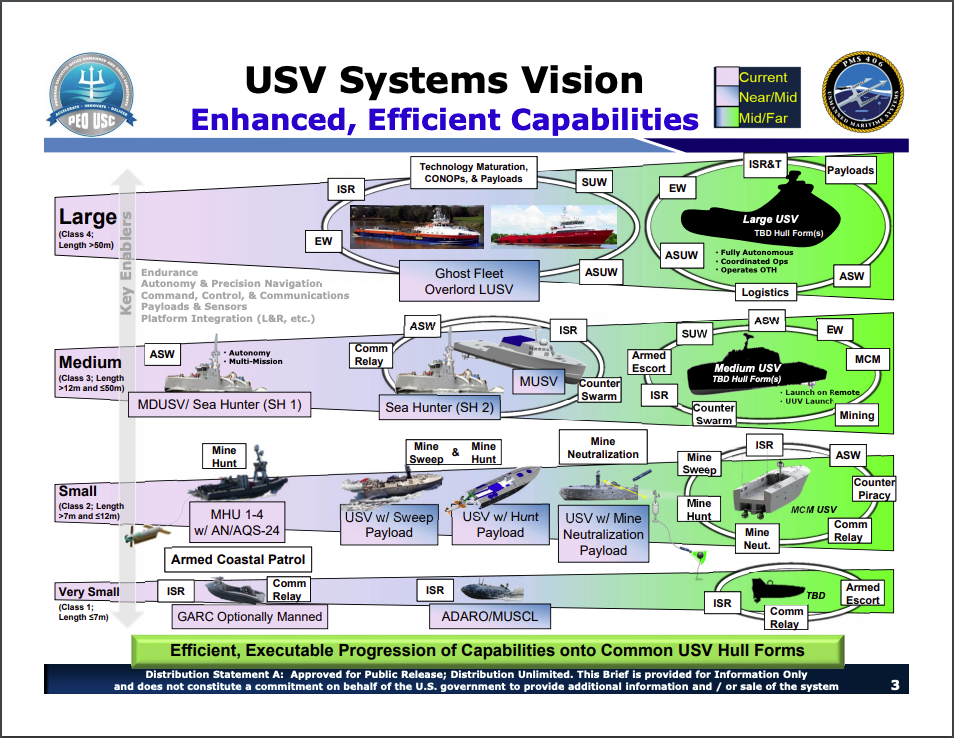
The Navy’s next force structure assessment likely will add significant numbers of large and medium-sized unmanned surface vessels to meet the challenges of a new era of Great Power competition, experts in maritime strategy and budget said on Monday.
The emphasis on unmanned for the new shift in fleet composition would show “the urgency with which the Navy is attaching the situation,” even without a concept of operations as to how these vessels would be used, Ronald O’Rourke, naval affairs specialist at the Congressional Research Service.
One reason for the move was the speed to which unmanned vessels can integrate into the fleet.
“You are much more likely to find a way to use” unmanned single-mission vessels in the fleet than new multi-mission manned vessels, said Bryan Clark, senior fellow of the Center for Strategic and Budgetary Assessments.
The working assumption is large unmanned vessels, about 300 feet in length, would be a weapons platform for 32 vertical launched missile cells with an integrated combat management system. The smaller medium-sized vessels, about 60 feet or so, would be used as sensors for persistent anti-submarine warfare or for command, control, communications, communications and intelligence or radar.
The administration is seeking $440 million to build two large unmanned vessels in its proposed budget, and the Navy is expected to send out a request for proposals on the smaller vessels later this spring or in early summer, Bryan McGrath, managing director of the FerryBridge group, said. He sees the unmanned vessels “as being autonomous in navigation and propulsion” for now but not for operations.
This move into larger investments in unmanned vessels fits with the service’s distributed maritime operations concept as outlined in testimony last month before the House Armed Services Seapower and Projection Forces Subcommittee.
The current budget submission reflects that idea, Eric Labs, senior analyst at the Congressional Budget Office said. By pushing back the buys for large ships, like amphibs and cruisers as well as aircraft, the Navy has upped the spending for directed energy, hypersonic weapons and unmanned vessels.
O’Rourke, noting Congress has been a major supporter of traditional shipbuilding and has pushed the shipbuilding budget up by about $2 billion a year. Both chambers are also having “a lot more discussions about sustaining this fleet, not just building it” to 355 ships, he said.
At the same time, the administration’s proposal to use emergency spending money [Overseas Contingency Operations] to ramp up defense “is a short-term gimmick,” Jerry Hendrix, vice president of the Telemus Group, said, and it “will likely go away after this administration goes.”

For now, it is on the table before the Armed Services Committee, which will begin their mark-ups next month.
The panelists agreed in their discussions and in answer to audience questions that Congress most likely would provide the funds to refuel nuclear aircraft carrier USS Harry S. Truman (CVN-75) and Los Angeles-class attack submarines and extend the service lives of Arleigh Burke-class destroyers. Also, Congress is expected to plus-up spending on large ships — from cruisers to amphibs.
“Manpower and operating costs are going up,” Clark said, and this is especially noticeable in ship classes that have undergone surface life extensions. Costs in manpower and operations “are growing faster than inflation; they are growing faster than the of the fleet.” One way to lower sustainment costs is to invest in unmanned systems. But to drive those costs down the investments in building need to be substantial, he said.
Clark said the announced 30-year shipbuilding plan was “more or less a placeholder” until the new assessment comes out. Speaking for himself, Labs also questioned Congress’ willingness to continue that level of spending over the 30 years envisioned by the plan. He and the others noted this was the “fourth correction” in long-term shipbuilding plans in recent years, raising concerns in the industrial base and among its suppliers about stability and predictability.
Other panelists added a realistic shipbuilding plan neede to consider the $7 billion per year projected spending on Columbia–class ballistic missile submarines and the unknown, unintended costs of adding six classes of ships to the fleet.
Labs stressed that the Navy “needs to socialize” its audiences, particularly Congress and the industrial base, for coming major changes in the mix and greater reliance on unmanned systems.
“Winter is coming,” McGrath said about the choices that will have to be made. “They need to make the case [to Congress] seapower is different” from the other services in terms of necessary investment in the future and investment for the long haul with its aircraft and vessels.”





